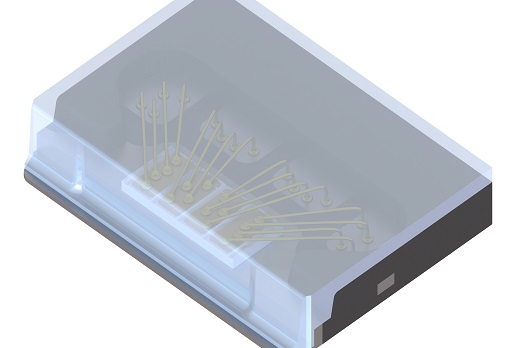Osram's new LiDAR lasers allow autonomous vehicles to “see” farther and more effectively
Two new infrared high-power SMT components for LiDAR (Light Detection and Ranging) applications extend options for system developers
Today, only a few future topics are discussed as profoundly as autonomous driving. The majority of system providers are convinced that there is no way around LiDAR when it comes to advancing autonomous driving. Osram has been a market leader in the development and production of these special infrared lasers for over 15 years. There are now more than ten million units in the field – without a single chip defect. With the world's first AEC-Q102 qualified four-channel and single-channel pulse laser, system developers can now choose from an even greater variety of infrared components from Osram. The two new products offer a convincing performance of 125 Watt per channel and an efficiency of up to 33 percent.
The requirements for safety systems in (semi-) autonomous vehicles are complex. They must be reliable, work in all lighting and weather conditions, identify potential hazards and obstacles in time to take appropriate driving decisions. There is now widespread agreement that only a combination of LiDAR, camera & radar is able to fulfill autonomous driving requirements. Osram introduced the first 905 nm laser to the market more than ten years ago. Today it is the most commonly used wavelength in LiDAR solutions. For instance, the 905 nm has a significant advantage compared to 1550 nm wavelength solutions, especially in terms of total system costs.
A central aspect in terms of safety is the range of the used infrared light source. A powerful laser is required to be able to look as far ahead as possible. Both products showcase an impressive output power of 125 Watt at 40 A per channel. Thanks to its particularly low thermal resistance of only 30 K/W for the single-channel-version (SPL S1L90A_3 A01) and 17 K/W for the four-channel device (SPL S4L90A_3 A01), heat is easily dissipated from the component - even at high currents.
The four-channel version features a chip with four emission areas that deliver an outstanding optical power at 480 Watt. The laser enables a much longer detection range, at a size of just 3.35 mm x 2.45 mm x 0.65 mm, making it only slightly larger than the single-channel-version (2.0 mm x 2.3 mm x 0.65 mm).
The two new high-power SMT (Surface Mountable Technology) lasers expand Osram’s photonics portfolio for LiDAR applications and offer ease of use for the customer in their system integration. “Thanks to their higher power and extended duty cycle range of up to 0.2 %, our customers can reach a longer detection range in the application and better resolution. Additionally, eye safe system designs can be achieved with these high power 905 nm products. Due to its excellent package design, the new products enable short pulse widths of around 2 ns," explains Rena Lim, Product Manager at Osram Opto Semiconductors.


ABOUT OSRAM
OSRAM, based in Munich, is a leading global high-tech company with a history dating back more than 110 years. Primarily focused on semiconductor-based technologies, our products are used in highly diverse applications ranging from virtual reality to autonomous driving and from smartphones to networked, intelligent lighting solutions in buildings and cities. OSRAM utilizes the infinite possibilities of light to improve the quality of life for individuals and communities. OSRAM’s innovations will enable people all over the world not only to see better, but also to communicate, travel, work, and live better. As of the end of fiscal year 2018 (September 30), OSRAM had approximately 26,200 employees worldwide. It generated revenue of more than €3.8 billion from continued operations in fiscal year 2018. The company is listed on the stock exchanges in Frankfurt and Munich (ISIN: DE000LED4000; WKN: LED400; trading symbol: OSR). Additional information can be found at www.osram.com.